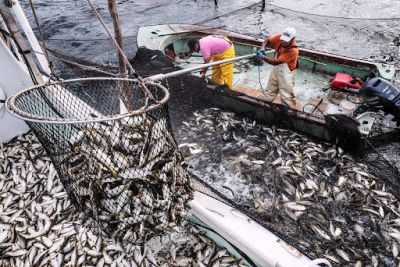By Philip C.

I was looking for a way to make a lot of money in a short period of time.
My teenage friends and I heard about an older menhaden fishing boat that was ready to go south but was short on crew. We talked to the Captain and signed on. The boat was to sail the next day at first light. It was summertime and our futures looked bright!
We went aboard to inspect the vessel and found an unused storeroom on the main deck. With permission from the Captain, we clean it out. It is to be our sleeping quarters. It seemed so much better than sleeping below with the rest of the crew. As it turned out, this did not sit too well with some of our mates. I guess they thought we were receiving special privileges. The first day at sea they threw a lot of our personal gear overboard. We had to stay vigilant…we could be next.
By the second day out we have entered the inland waterway. This is idle time for most of the crew and after hearing some not too subtle remarks in the galley at breakfast, this could be the day we go for a swim. Since there were no duties for the three of us, we decided the safest place to be was on the crow’s nest at the top of the mast!
We climbed the 35 feet up the rigging, got in the crow’s nest and stood on the trap door. No swimming today…we’re safe!
We soon noticed a vessel to our stern. It was one of the new steel hull fishing steamers. It was much larger and faster than our old wooden boat. As it drew closer, it was obvious it did not want to be held up by our slower boat.
Our Captain moved over as far as possible in the narrow waterway. The big boat, with its horn blaring, started its run past us. When we were side by side, somehow the two boats collided. There was scraping and banging as parts of our railings and cabin doors were ripped away. The impact caused our old boat to keel over to the left as the steamer slipped past. When our boat started to right herself, the movement in the crow’s nest, where we were still hiding out 35 feet above the deck, was swift and violent. We struggled to hug the crow’s nest railing to keep from being catapulted into the pine trees on the opposite bank.
Once the boat had settled, the crew discovered the collision had opened planks in the boats hull. We were taking on water! The crew did the best they could to stop the leaks, but it would not hold for long. We were forced to stop at a shipyard for repairs. I could see this delay would cost me money. No fish, no funds.
When the repairs to our boat are finally complete, we head for our home port in North Carolina. It is now day three.
We tie up at the town dock. There is nothing for us to do so the Capitan dismissed us for the evening. The boat will sail again at midnight.
We walk up the street to the company office building. Everyone has left for the day except two young secretaries. After a little conversation, the girls agree to let us use the executive office showers. After a quick clean up and some “borrowed” Aqua Velva, we are ready to hit the town.
Some food, a movie and a few refreshments later, the time has slipped away.
We head back to the town dock and our boat only to discover our boat has moved from the town dock further down to the fish factory. We start walking…it’s quite a hike and it’s getting late. Walking turns to jogging…it’s getting later. Jogging turns to running.
As we get closer, we see the lights on the old steamer as it makes its way out of the fish factory port. We have missed the boat.
Now we have to walk all the way back to town to find a place to sleep, which turns out to be a shared room in a boarding house. We paid a lot of our money for a very short night.
We hang around the factory all the next day waiting for our boat to return. Finally, in late afternoon, she lumbers in, loaded to the gunnels with fish. Not our fish. No fish, no funds. My money is going out but so far, none has come in. But tomorrow we fish. Day four has now passed.
We leave port sometime after midnight. All crew members are required to stand a “trick at the wheel,” – steer the boat for a two- hour shift. My turn comes at 2 am. It’s pitch black outside and the only light in the wheelhouse is a small light on the compass. A seasoned crewman is with me. He has a mug of coffee in one hand and a lighted cigarette in the other. He points to the compass with the cigarette and says “steer this course.”
“Aye, Aye,” I reply. (I’m a pro.)
A giant swell suddenly lifts the boat. When it settles, it’s pointing, by the compass reading, several degrees to the left. Make that “port.” I am a pro.
The helm is about five feet in diameter, and I manhandle it to the right (starboard). Now I’m several degrees in the other direction. After two hours of zig zagging, my relief takes over.
We reach our holding spot in the ocean. We drift, waiting for the sun to rise so our spotter aircraft can search for fish. It’s time for breakfast, but after all that ship rolling, I don’t think my stomach is ready for whatever is being fried in the galley. I grab a large package of Fig Newtons and have my breakfast on deck. Dawn breaks, the airplane is up. I’m decked out in my new black oilskins, hat, pants, jacket and black rubber boots. It is now day five. The spotter pilot reports he has located a large school of Menhaden – maybe 500,000. We steam north at all possible speed. My fortune is at hand. I have dollar signs in my head but a very different feeling in my stomach.
Once we were “on the fish,” two small boats, carrying the nets, were launched and boarded in some very rough water. These boats then race out and surround the school of fish with the nets. As powerful “blocks” mounted overhead start to reel in the net, my job, with the others, is to spread the net evenly in the bottom of the boat in order to be ready for the next “set.”
By now the sun is up and the temperature is near 80. Inside my waterproof, air proof oilskins, it is much hotter. Some cooling is felt by water pouring on me from the net being hauled in overhead. Also pouring down are sea nettles, seaweed and small parts of bloody fish, as well as overhead contributions being made by the thousands of seagulls hoping for a free meal.
After an hour, I’m hot, exhausted, and the boat continues to pitch. I’ve thrown up twice, those Fig Newtons are history. We are off the Outer Banks of North Carolina, and I can see the Wright Brothers Monument. It does not appear to be very far and in my hallucinogenic state, I’m ready to peel off my oilskins and swim for shore. A couple of large black fins quickly bring me back to reality.
Once our catch is pumped aboard the steamer, we head south toward the factory. The Captain is hoping to make another “set” on the way back. I’m praying the fish will “go deep” and not be spotted.
After a week we have had enough! I think the Captain was relieved to see us go. There were plenty of able hands around the docks to take our place.
We hitched a ride with a spotter pilot and flew home. After expenses, my oilskins, movie, food, refreshments and my share for the room for a night, my “fish” money was about depleted.
I just wanted to make a lot of money in a short period of time…but I couldn’t stay in the boat.
Editor’s Note: Menhaden fishing boats from the 1950’s averaged 140 feet in length. Once power blocks were developed to pull in the nets crew size was reduced from approximately 25 men to 15. (Pictures courtesy of Reedville Fisher-men’s Museum)
